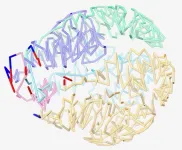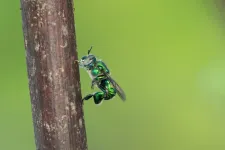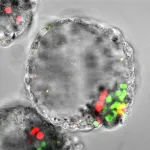(Press-News.org) RIVERSIDE, Calif. -- 'Tis the season for hiking now that spring has arrived and temperatures are on the upswing. But with hikes come insect bites and on the increase in North America is babesiosis, a malaria-like disease spread especially between May and October by a tick.
Indeed, recent research suggests an increase in the incidence of diseases transmitted by ticks around the world, not just the United States and Canada, due likely to climate change and other environmental factors. Among the tick-borne pathogens, Babesia parasites, which infect and destroy red blood cells, are considered a serious threat to humans and animals. All cases of human babesiosis reported in the United States have been linked to either Babesia microti, B. duncani, or a B. divergens-like species.
Now a research team led by scientists at the University of California, Riverside, and Yale University reports the first high-quality nuclear genome sequence and assembly of the pathogen B. duncani. The team also determined the 3D genome structure of this pathogen that resembles Plasmodium falciparum, the malaria-causing parasite.
“Our data analysis revealed that the parasite has evolved new classes of multigene families, allowing the parasite to avoid the host immune response,” said Karine Le Roch, a professor of molecular, cell and systems biology at UC Riverside, who co-led the study with Choukri Ben Mamoun, a professor of medicine at Yale University.
According to Le Roch, who directs the UCR Center for Infectious Disease Vector Research, the study, published today in Nature Microbiology, not only identifies the molecular mechanism most likely leading to the parasite’s pathogenicity and virulence, but also provides leads for the development of more effective therapies.
“By mining the genome and developing in vitro drug efficacy studies, we identified excellent inhibitors of the development of this parasite — a pipeline of small molecules, such as pyrimethamine, that could be developed as effective therapies for treating and better managing human babesiosis,” Le Roch said. “Far more scientific and medical attention has been paid to B. microti. The genome structure of B. duncani, a neglected species until now, will provide scientists with important insights into the biology, evolution, and drug susceptibility of the pathogen.”
Human babesiosis caused by Babesia duncani is an emerging infectious disease in the U.S. and is often undetected because healthy individuals do not usually show symptoms. It has, however, been associated with high parasite burden, severe pathology, and death in multiple cases. Despite the highly virulent properties of B. duncani, little was known about its biology, evolution, and mechanism of virulence, and recommended treatments for human babesiosis against B. duncani are largely ineffective.
A strong immune system is required to fight the pathogen. A compromised immune system could lead to flu-like illness. The tick that spreads babesiosis is mostly found in wooded or grassy areas and is the same tick that transmits bacteria responsible for Lyme disease. As a result, around 20% of patients with babesiosis are co-infected with Lyme disease.
B. duncani mostly infects deer, which serve as the reservoir host during the pathogen’s asexual development. The parasite’s sexual cycle occurs in the tick after the tick bites the infected deer. When this tick bites humans, infection begins. The full life cycle of Babesia parasites has not yet been determined. The tick that spreads babesiosis, called Dermacentor albipictus, lives longer than mosquitoes and could facilitate a long life cycle for B. duncani.
Even though scientists are discovering more Babesia species, diagnostics are mostly developed for B. microti. Le Roch is already working with Stefano Lonardi, a professor of computer science and engineering at UCR and co-first author of the study, on new Babesia strains that have evolved.
“The Babesia genomes are not very long,” said Lonardi, who assembled the B. duncani strain. “But they are challenging to assemble due to their highly repetitive content and can require years of research. Once the genome is assembled and annotated, it can provide valuable information, such as how the genes are organized, which genes are transcribed during infection, and how the pathogen avoids the host’s immune system.”
In older and immunocompromised people, if B. duncani is left unattended, babesiosis could worsen and lead to death. Once the pathogen enters the body and red blood cells start to get destroyed, fever, headache, and nausea can follow. People who get bitten by the ticks often don’t feel the bite, which complicates diagnosis. Skin manifestations of babesiosis are rare, Lonardi said, and difficult to separate from Lyme disease.
Le Roch and Lonardi urge people to be mindful of ticks when they go hiking.
“Check yourself for tick bites,” Le Roch said. “When you see your physician don’t forget to let them know you go hiking. Most physicians are aware of Lyme disease but not of babesiosis.”
Next the team plans to study how B. duncani survives in the tick and find novel vector control strategies to kill the parasite in the tick.
Le Roch, Mamoun, and Lonardi were joined in the study by colleagues at UCR, Yale School of Medicine, Université de Montpellier (France), Instituto de Salud Carlos III (Spain), Universidad Nacional Autónoma de México, and University of Pennsylvania. Pallavi Singh at Yale and Lonardi contributed equally to the study. The B. duncani genome, epigenome, and transcriptome were sequenced at UCR and Yale.
The study was supported by grants from the National Institutes of Health, Steven and Alexandra Cohen Foundation, Global Lyme Alliance, National Science Foundation, UCR, and Health Institute Carlos III.
The research paper is titled “Babesia duncani multi-omics identifies virulence factors and drug targets.”
The University of California, Riverside is a doctoral research university, a living laboratory for groundbreaking exploration of issues critical to Inland Southern California, the state and communities around the world. Reflecting California's diverse culture, UCR's enrollment is more than 26,000 students. The campus opened a medical school in 2013 and has reached the heart of the Coachella Valley by way of the UCR Palm Desert Center. The campus has an annual impact of more than $2.7 billion on the U.S. economy. To learn more, visit www.ucr.edu.
END
Researchers warn of tick-borne disease babesiosis
UC Riverside and Yale University team sequences and mines genome of the pathogen Babesia duncani
2023-04-13
ELSE PRESS RELEASES FROM THIS DATE:
Where did the first sugars come from?
2023-04-13
LA JOLLA, CA— Two prominent origin-of-life chemists have published a new hypothesis for how the first sugars—which were necessary for life to evolve—arose on the early Earth.
In a paper that appeared on April 13, 2023, in the journal Chem, the chemists from Scripps Research and the Georgia Institute of Technology propose that key sugars needed for making early life forms could have emerged from reactions involving glyoxylate (C2HO3–), a relatively simple chemical that plausibly existed on the Earth before life evolved.
“We show that our new hypothesis has key advantages over the more traditional view ...
Conservation: Red-throated loons avoid North Sea windfarms
2023-04-13
Offshore wind farms in the North Sea reduce the population of loons –fish-eating aquatic birds also known as divers – by 94% within a one-kilometre zone, according to new research published in Scientific Reports. The findings highlight the need to minimise the impact of offshore wind farms on seabirds, while balancing this effort with the demand for renewable energy.
Previous research has found that different seabird species respond to offshore windfarms differently – they may avoid the area which can lead to habitat displacement or they may be attracted to the area which can increase mortality via collisions with the turbines. However, it is difficult ...
Why orchid bees concoct their own fragrance
2023-04-13
Male bees display a remarkable passion for collecting scents: they deposit scents from various sources in special pockets on their hind legs, thus composing their own fragrance. This behaviour has been known since the 1960s. The reason why they do it has been the subject of much speculation just as long. Researchers from Ruhr University Bochum, Germany, in collaboration with colleagues from the University of California at Davis and the University of Florida at Fort Lauderdale, have finally solved the mystery. The bee fragrance serves as a sex attractant and increases the reproductive success of the males, as the team found out after three years ...
Uncovering hidden mitochondrial mutations in single cells
2023-04-13
A high-throughput single-cell single-mitochondrial genome sequencing technology known as iMiGseq has provided new insights into mutations of mitochondrial DNA (mtDNA) and offers a platform for assessing mtDNA editing strategies and genetic diagnosis of embryos prior to their implantation.
An international team of researchers, led by KAUST stem cell biologist Mo Li, has now quantitatively depicted the genetic maps of mtDNA in single human oocytes (immature eggs) and blastoids (stem cell-based synthetic embryos)[1]. This has revealed molecular features of rare mtDNA mutations that cause maternally inherited diseases.
Mitochondria, the ...
Effectiveness of COVID-19 mRNA vaccination for children and adolescents confirmed by multi-state study
2023-04-13
A multi-state study from the Centers for Disease Control and Prevention’s (CDC’s) VISION Network confirms that the Pfizer-BioNTech mRNA COVID-19 vaccine has provided children and adolescents, ages 5-17, with protection against both moderate and severe COVID-19 outcomes.
The study found that for 12-17 year olds, vaccine effectiveness was high against the Delta variant but lower during Omicron dominance, including BA.4 and BA.5. Due to the youngest age (5-11) group’s ineligibility for vaccination during Delta predominance, vaccine effectiveness could be estimated for these children only during the Omicron predominant ...
Four early-career cancer researchers earn prestigious annual award from NCCN Foundation
2023-04-13
PLYMOUTH MEETING, PA [April 13, 2023] — The National Comprehensive Cancer Network® (NCCN®) and the NCCN Foundation® today announced four winners for the 2023 NCCN Foundation Young Investigator Awards. These annual awards honor up-and-coming leaders in oncology research working to investigate and advance cancer care. The honorees will each receive up to $150,000 in funding for projects that will run over two years. The selection process is overseen by the NCCN Oncology Research Program (ORP) which will also provide oversight.
“It is a privilege to support these emerging innovators ...
Some people may be attracted to others over minimal similarities
2023-04-13
We are often attracted to others with whom we share an interest, but that attraction may be based on an erroneous belief that such shared interests reflect a deeper and more fundamental similarity—we share an essence—according to research published by the American Psychological Association.
“Our attraction to people who share our attributes is aided by the belief that those shared attributes are driven by something deep within us: one’s essence,” said lead author Charles Chu, PhD, an assistant professor at the Boston University Questrom School of Business. “To put it concretely, we like someone who agrees with us on a political issue, shares our music ...
The Biophysical Journal launches Postdoctoral Reviewer Program
2023-04-13
Today the Biophysical Journal is launching a new initiative, the Postdoctoral Reviewer Program. The program provides postdoctoral researchers in biophysics the opportunity to partner with Associate Editors and complete reviews that will be used in deciding whether articles will be accepted for publication.
Candidates for this program must be in a postdoctoral position during the 2023–2024 academic year and a member of BPS in good standing. Applications for the new program will be accepted through July 1 for a single-year term beginning in September 2023. Interested candidates can find more information about the program and application process online.
“I am extremely ...
Scientists create high-efficiency sustainable solar cells for IoT devices with AI-powered energy management
2023-04-13
Newcastle University researchers have created environmentally-friendly, high-efficiency photovoltaic cells that harness ambient light to power internet of Things (IoT) devices.
Led by Dr Marina Freitag, the research group from the from School of Natural and Environmental Sciences (SNES) created dye-sensitized photovoltaic cells based on a copper(II/I) electrolyte, achieving an unprecedented power conversion efficiency of 38% and 1.0V open-circuit voltage at 1,000 lux (fluorescent lamp). The cells are non-toxic and environmentally friendly, setting a new standard for sustainable ...
A sharper look at the M87 black hole
2023-04-13
The iconic image of the supermassive black hole at the center of M87—sometimes referred to as the “fuzzy, orange donut”—has gotten its first official makeover with the help of machine learning. The new image further exposes a central region that is larger and darker, surrounded by the bright accreting gas shaped like a “skinny donut.” The team used the data obtained by the Event Horizon Telescope (EHT) collaboration in 2017 and achieved, for the first time, the full resolution of the array.
In 2017, the EHT collaboration used a network of seven pre-existing telescopes ...
LAST 30 PRESS RELEASES:
Making lighter work of calculating fluid and heat flow
Normalizing blood sugar can halve heart attack risk
Lowering blood sugar cuts heart attack risk in people with prediabetes
Study links genetic variants to risk of blinding eye disease in premature infants
Non-opioid ‘pain sponge’ therapy halts cartilage degeneration and relieves chronic pain
AI can pick up cultural values by mimicking how kids learn
China’s ecological redlines offer fast track to 30 x 30 global conservation goal
Invisible indoor threats: emerging household contaminants and their growing risks to human health
Adding antibody treatment to chemo boosts outcomes for children with rare cancer
Germline pathogenic variants among women without a history of breast cancer
Tanning beds triple melanoma risk, potentially causing broad DNA damage
Unique bond identified as key to viral infection speed
Indoor tanning makes youthful skin much older on a genetic level
Mouse model sheds new light on the causes and potential solutions to human GI problems linked to muscular dystrophy
The Journal of Nuclear Medicine ahead-of-print tip sheet: December 12, 2025
Smarter tools for peering into the microscopic world
Applications open for funding to conduct research in the Kinsey Institute archives
Global measure underestimates the severity of food insecurity
Child survivors of critical illness are missing out on timely follow up care
Risk-based vs annual breast cancer screening / the WISDOM randomized clinical trial
University of Toronto launches Electric Vehicle Innovation Ontario to accelerate advanced EV technologies and build Canada’s innovation advantage
Early relapse predicts poor outcomes in aggressive blood cancer
American College of Lifestyle Medicine applauds two CMS models aligned with lifestyle medicine practice and reimbursement
Clinical trial finds cannabis use not a barrier to quitting nicotine vaping
Supplemental nutrition assistance program policies and food insecurity
Switching immune cells to “night mode” could limit damage after a heart attack, study suggests
URI-based Global RIghts Project report spotlights continued troubling trends in worldwide inhumane treatment
Neutrophils are less aggressive at night, explaining why nighttime heart attacks cause less damage than daytime events
Menopausal hormone therapy may not pose breast cancer risk for women with BRCA mutations
Mobile health tool may improve quality of life for adolescent and young adult breast cancer survivors
[Press-News.org] Researchers warn of tick-borne disease babesiosisUC Riverside and Yale University team sequences and mines genome of the pathogen Babesia duncani







